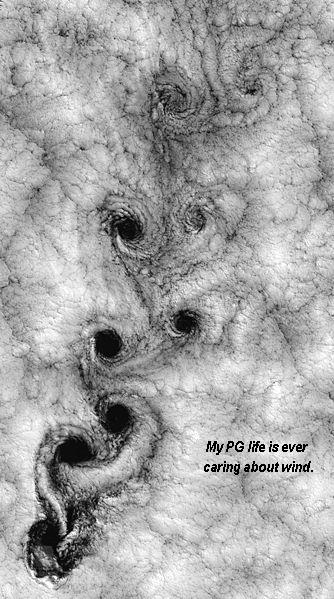-
Ever the wind is in my thoughts and studies!
- Meterology
- Rotors
- Turbulence
- Thermals
-
Meteorología Basica
- Thermal visualization
- Use radio-control UAV coupled with one's flight
- Using trained birds coupled with one's flight
- Turbulence visualization instruments
- Expert programs learn flight/vario reports to produce guide
- Need much more than average wind speed!
• Wind speed probability distribution
• Turbulence
• Vertical shear
• Extreme winds
• Extreme coherent gusts
• Temperatures
• Probability of thunderstorms, hail, icing, tornados, hurricane
- Artificial lift, artificial thermals, thermal triggers, fences,
artificial dunes,
- windfield helicities
- near-ground turbulence and effects on various wing types
- near-ground turbulence and effects on soft-canopy string-formed
wings
-
http://www.laboratoridenvol.com/projects/dune/dune.en.html
- Planetary boundary layer PBL
wiki
-
http://en.wikipedia.org/wiki/Geostrophic_wind
|
|
Tags and notes There
is a lot of scattered aerial freak wave knowledge for us to study, but
seemingly no definitive compilation of the zoo of effects. Cristina Archer
reports new access to better windfield data sets, so freak sky waves
should now appear there at the meteorological "micro-scale" (~1000 m).
Much of the below is from scattered sources and personal observation.
Atmospheric gravity waves are generally surface waves between air layers
and easily break as Kelvin-Helmholtz instability. Rising terrain and
inversion or convection bubbles commonly trip gravity waves to break.
Atmospheric wave peaks break just as whitecaps do, progressively more in
storm conditions. It gets really interesting with strong spiral
hodographic shear. Freak waveforms occur by many causes, like giant
shockwaves caused by major mountains, fronts, or storms. A wave can
manifest as a deep isolated trough. Perhaps the freakiest wave is
perfectly canceled into momentary nonexistence.
Sky waves are easily seen when conditions are right, but one must
visualize the large-scale action sped up. Our northern coastal skies spend
a lot of time just at dew-point, allowing layers and vortical cores to
appear. Often hidden structure reveals as cloud decays, as condensation
evaporates or precipitates out. On the edge of the sun's disc, when rising
or setting, atmospheric layers are visible, with crossing surface waves.
There are endless nature videos showing this effect inadvertently and a
few time lapse videos showing large gravity wave crossing stratus cloud
layers. Often a convective cell pushes at the windfield around it,
revealing layers and waves. One can see breaking wave turbulence faintly
across twinkling star fields. Even carefully observed bird flight reveals
wave motion.
Downburst (and microburst) studies in aviation extensively studied that
phenomenon with doppler radar, so airplanes are now rarely at risk. These
are vertical down-jets with waves of ring and horseshoe vortices around
them. A falling pocket of dry/drying cold air is common, but heats in a
pulse as it strikes the surface and can even somewhat bounce. Heavy rain
can accelerate a downward jet. Large virga downbursts can occur as
breaking waves experienced as white squalls. Willywaws in Tierra del Fuego
that Slocum described are extreme versions of the virga catpaws the
ordinary sailor sees.
A kite signals an ordinary wave by "bobbing" up and down slowly, and a
small breaking gravity wave when it is suddenly kicked from above or
behind, with a sort of washing machine tumbling--fairly common in gusty
conditions. In extreme cases the kite seems to be slapped out of the sky.
A vertical vortex as an invisble "gustnado" is a common encounter, seen as
a horizontally polarized wave that violently yaws the kite.
Breaking waves are so common that Airborne Wind Energy systems must
generally be able to cope with several extreme events a year. Altitude is
a safety factor, and kites that survive crashes are currently essential.
Spanning ordinary turbulence with megascale crosslinked kite structure is
very effective in ordinary conditions. Better imaging and prediction,
along with better flight automation, will ease the freak sky wave issue.
Sailors also will be better prepared, with knock-down warning systems
feasible,
daveS
29Sept2011 |
